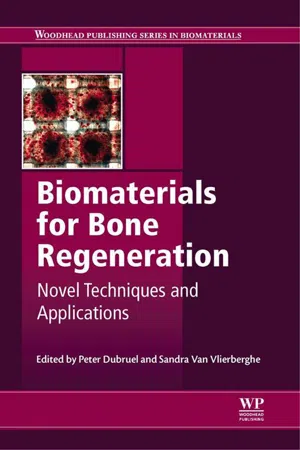
Biomaterials for Bone Regeneration
Novel Techniques and Applications
- 502 pages
- English
- ePUB (mobile friendly)
- Available on iOS & Android
About This Book
Novel Biomaterials for Bone Regeneration provides a comprehensive review of currently available biomaterials and how they can be applied in bone regeneration. In recent decades, there has been a shift from the idea of using biomaterials as passive substitutes for damaged bones towards the concept of biomaterials as aids for the regeneration of a host's own bone tissue. This has generated an important field of research and a range of technological developments.
Part one of this book discusses a wide range of materials, including calcium phosphate cements, hydrogels, biopolymers, synthetic polymers, and shape memory polymers. Part two then turns to the processing and surface modification of biomaterials, as well as how biomaterials can be evaluated both for their mechanical properties and for immunocompatibility with the host. Finally, part three covers a variety of cellular approaches, and production and delivery of biomaterials for bone regeneration. Chapters also consider the potential of electromagnetic and ultrasonic stimulation of biomaterials to aid in the regenerative process.
Novel Biomaterials for Bone Regeneration represents an important resource for academics, clinicians, and industry professionals working in the area of biomedical materials, providing them with both an overview of the current state-of-the-art, and an indication of potential future developments.
- Provides comprehensive coverage of novel materials, techniques, and applications of biomaterials for bone regeneration
- Provides vital information on the various types of materials used in bone regeneration
- Discusses processing, modification, and evaluation techniques of biomaterials, and looks at cellular approaches and stimulation of biomaterials for bone regeneration
Frequently asked questions
Information
Calcium phosphate cements for bone regeneration
Abstract:
Key words
1.1 Introduction
1.2 Calcium phosphate cements (CPCs)
| Ca/P Molar ratio | Compound | Chemical formula |
| 0.5 | Monocalcium phosphate monohydrate | Ca(H2PO4)2 · H2O |
| 1.00 | Brushite (DCPD) | CaHPO4 · 2H2O |
| 1.00 | Monetite (DCPA) | CaHPO4 |
| 1.33 | Octacalcium phosphate (OCP) | Ca8(HPO4)2(PO4)4 · 5H2O |
| 1.20–2.20 | Amorphous calcium phosphate (ACP) | CaxHy(PO4)z · nH2O, n = 3–4.5; 15–20% H2O |
| 1.50 | α-Tricalcium phosphate (α-TCP) | α-Ca3(PO4)2 |
| 1.50 | β-Tricalcium phosphate (β-TCP) | β-Ca3(PO4)2 |
| 1.67 | Hydroxyapatite (Hap) | Ca10(PO4)6(OH)2 |
| 1.67 | Fluorapatite (FAP) | Ca10(PO4)6 F2 |
| 2.00 | Tetracalcium phosphate | Ca4(PO4)2O |
1.2.1 Metastable cements
1.2.2 Apatite cements
| Manufacturer | Cement name | Chemical formulation | End product |
| Stryker-Leibinger Corporation | BoneSource® | Powder: TTCP (73%), DCP (27%) Solution: H2O, mixture of Na2HPO4 and NaH2PO4 | Apatite |
| Biomet | Calcibons® | Powder: α-TCP (61%), DCP (26%), CaCO3 (10%), PHA (3%) Solution: H2O, Na2HPO4 | Apatite |
| Kyphon | KyphOsTM® | Powder: α-TCP (77%), Mg3 (PO4)2 (14%), MgHPO4 (4.8%), SrCO3 (3.6%) Solution: H2O, (NH4)2HPO4 (3.5 M) | Apatite |
| Synthes-Norian | Norian SRS® Norian CRS® | Powder: α − TCP (85%), CaCO3 (12%), MCPM (3%) Solution: H2O, Na2HPO4 | Apatite |
Table of contents
- Cover image
- Title page
- Table of Contents
- Copyright
- Contributor contact details
- Woodhead Publishing Series in Biomaterials
- Dedication
- Foreword
- Part I: Materials for bone regeneration
- Part II: Processing, surface modifi cation and evaluation of biomaterials for bone regeneration
- Part III: Cellular approaches and physical stimulation of biomaterials for bone regeneration applications
- Index
